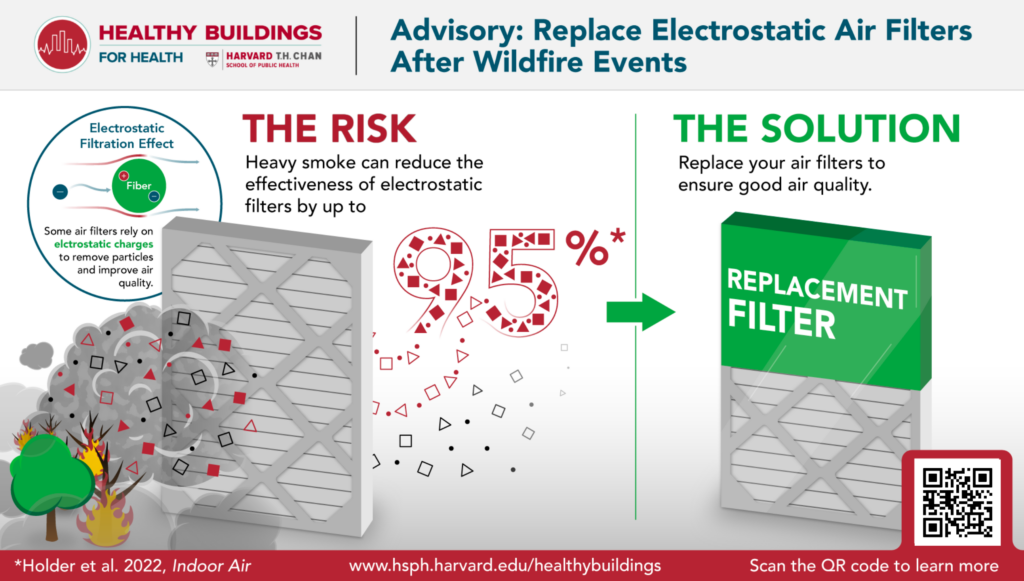In collaboration with the University of Hawai’i at Manoa (UH) and community members, researchers of the Harvard Healthy Buildings Program are collecting data to examine human health risks of wildfire-related pollutants in homes following the Maui wildfires last August. The study is funded by the National Science Foundation (NSF) and aims to assess a comprehensive range of factors influencing people’s indoor exposure to wildfire air pollutants. With a better understanding of the long-term health impacts of wildfires, effective, reliable, and affordable intervention strategies and tools can be developed to improve indoor air quality during and after such catastrophic events.

Last August, devastating wildfires in Lahaina, Maui, caused extensive destruction, displacements, and deaths [1]. The fire is contained, but the health and well-being of people in and around the damaged regions will continue to be affected in numerous ways [1]. Wildfire smoke can affect chronic health conditions like heart or pulmonary diseases for years [2]. The smoke generates harmful pollutants that degrade air quality and can find their way indoors. People staying in buildings without proper remediation can be exposed to fire-related contaminants in the air, water, soil, and hazardous materials long after the wildfires are contained and public attention moves on [1].
Understanding the Long-term Health Impacts of Wildfire-related Pollutants in Homes
The goal of this study, funded by the National Science Foundation (NSF), is to measure the concentrations of wildfire-related pollutants in the indoor and outdoor air and on indoor surfaces in homes located in Lahaina, Maui, and nearby regions affected by the wildfires last August. The team of researchers aims to examine three categories of target pollutants, including particulate matter (PM), volatile organic compounds (VOCs), and polycyclic aromatic hydrocarbons (PAHs), which are emitted vastly during wildfire events and cause a wide range of health complications [3]. Additionally, they will determine the degree to which wildfire-related outdoor air pollutants have infiltrated homes and assess the short and long-term reductions of air pollutants using portable air cleaners (PACs).
Community Information and Support in Collaboration with Local Partners
The collected data will inform scientific advancement and ultimately benefit affected communities. To ensure our work is locally relevant, equitable, just, and efficient, the team works with local community partners and researchers from the University of Hawai’i at Manoa (UH), who lead the community engagement and support us in the field.
This study will provide much-needed information on indoor exposure to wildfire air pollution and the effectiveness of reduction strategies to protect human health in affected communities. Health scientists can use the findings to establish resilient indoor environments. Urban managers, public health officials, emergency responders, and insurance companies can gain a better understanding of the long-term health impacts of wildfires and develop timely strategies for disaster management and public health protection. Together with local partners, we want to inform communities and educate families about the respiratory health risks resulting from wildfires and accessible and practical solutions that can help mitigate them.
Improving Indoor Air Quality in Your Home
There are steps you can take to help reduce your indoor exposure to wildfire air pollution and protect your health. The Harvard Healthy Buildings Team has developed different free-to-use tools to protect your home from harmful pollutants and create healthy indoor environments.
Selecting Appropriately Sized Portable Air Cleaners (PACs): Existing research shows PACs can reduce particulate matter (PM) exposures to some degree [4][5]. Our Portable Air Cleaner Sizing (PACS) tool helps you select an appropriately sized portable air cleaner for indoor spaces based on your buildings’ unique needs.
Building Your Own Air Cleaner: Learn about the basics of air cleaners and how to make your own. We provide three cost-effective do-it-yourself options with step-by-step instructions to build them.
Understanding Air Filters and Wildfire Smoke: Keep in mind that wildfires impact filter performance. Therefore, replace electrostatic air filters after wildfire events. Find our recommendations here.

General Tips for Healthy Homes: Explore our 36 expert tips for each room to improve the health of your home.
Discover more tools, guides, and other solutions to help communities apply our research to their everyday lives.
Sources
[1] County of Maui Communications Office, “9/04 MAUI WILDFIRE DISASTER UPDATE.” Sep. 04, 2023. Accessed: Sep. 04, 2023. [Online]. Available: https://www.mauicounty.gov/DocumentCenter/View/142793/COM-News-Release—Maui-Wildfire-Disaster-Update-20230904
[2] E. Grant and J. D. Runkle, “Long-term health effects of wildfire exposure: A scoping review,” J. Clim. Change Health, vol. 6, p. 100110, May 2022, doi: 10.1016/j.joclim.2021.100110.
[3] H. Chen, J. M. Samet, P. A. Bromberg, and H. Tong, “Cardiovascular health impacts of wildfire smoke exposure,” Part. Fibre Toxicol., vol. 18, no. 1, p. 2, Jan. 2021, doi: 10.1186/s12989-020-00394-8.
[4] A. L. Holder, H. S. Halliday, and L. Virtaranta, “Impact of do-it-yourself air cleaner design on the reduction of simulated wildfire smoke in a controlled chamber environment,” Indoor Air, vol. 32, no. 11, p. e13163, Nov. 2022, doi: 10.1111/ina.13163.
[5] J. Xiang et al., “Field measurements of PM2.5 infiltration factor and portable air cleaner effectiveness during wildfire episodes in US residences,” Sci. Total Environ., vol. 773, p. 145642, Jun. 2021, doi: 10.1016/j.scitotenv.2021.145642.





